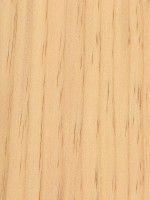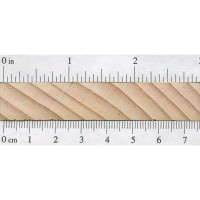 |
Common Name(s): Sugar Pine Scientific Name: Pinus lambertiana Distribution: Mountainous regions of Pacific coast of United States Tree Size: 130-200 ft (40-60 m) tall, 3-5 ft (1-1.5 m) trunk diameter Average Dried Weight: 25 lbs/ft3 (400 kg/m3) Specific Gravity (Basic, 12% MC): .34, .40 Janka Hardness: 380 lbf (1,690 N) Modulus of Rupture: 8,200 lbf/in2 (56.6 MPa) Elastic Modulus: 1,190,000 lbf/in2 (8.21 GPa) Crushing Strength: 4,460 lbf/in2 (30.8 MPa) Shrinkage: Radial: 2.9%, Tangential: 5.6%, Volumetric: 7.9%, T/R Ratio: 1.9 |
Color/Appearance: Heartwood is a light brown, sometimes with a slightly reddish hue. Sapwood is a pale yellow to nearly white. Flatsawn surfaces frequently exhibit small brown streaks from the conspicuous resin canals present in the tree.
Grain/Texture: Grain is straight with an even, medium to coarse texture.
Endgrain: Very large resin canals, numerous and evenly distributed, mostly solitary; earlywood to latewood transition gradual, color contrast low; tracheid diameter medium-large to very large.
Rot Resistance: The heartwood is rated as moderate to low in decay resistance.
Workability: Sugar Pine is easy to work with both hand and machine tools. Glues and finishes well.
Odor: While not nearly as pronounced as many species of Southern Yellow Pine, Sugar Pine has a faint, sweet odor while being worked.
Allergies/Toxicity: Working with pine has been reported to cause allergic skin reactions and/or asthma-like symptoms in some people. See the articles Wood Allergies and Toxicity and Wood Dust Safety for more information.
Pricing/Availability: Sugar Pine is widely harvested for construction lumber (particularly in California). It’s a member of the White Pine group, and is sold with other species interchangeably. Prices should be moderate to high for a domestic softwood.
Sustainability: This wood species is not listed in the CITES Appendices, and is reported by the IUCN as being a species of least concern.
Common Uses: Crates, boxes, interior millwork, construction lumber, and musical instruments (piano keys).
Comments: Sugar Pine is the largest of all species of pine, attaining heights of over 200 feet; it’s sheer size, coupled with its thick and massive branches, have lead some botanists to also describe it as the most majestic species of pine as well.
The wood of Sugar Pine is classified as white pine: this group is sometimes called soft pine, in contrast to the harder yellow pines found in the eastern United States. (The other two primary soft pine species are Eastern White Pine and Western White Pine.) Sugar Pine is significantly lighter and weaker than the species of Southern Yellow Pine, though it has excellent dimensional stability, and is frequently used in the production of patterns/templates and applications where stability is important.
- Austrian Pine (Pinus nigra)
- Caribbean Pine (Pinus caribaea)
- Eastern White Pine (Pinus strobus)
- Jack Pine (Pinus banksiana)
- Jeffrey Pine (Pinus jeffreyi)
- Khasi Pine (Pinus kesiya)
- Limber Pine (Pinus flexilis)
- Loblolly Pine (Pinus taeda)
- Lodgepole Pine (Pinus contorta)
- Longleaf Pine (Pinus palustris)
- Maritime Pine (Pinus pinaster)
- Ocote Pine (Pinus oocarpa)
- Patula Pine (Pinus patula)
- Pinyon Pine (Pinus edulis)
- Pitch Pine (Pinus rigida)
- Pond Pine (Pinus serotina)
- Ponderosa Pine (Pinus ponderosa)
- Radiata Pine (Pinus radiata)
- Red Pine (Pinus resinosa)
- Sand Pine (Pinus clausa)
- Scots Pine (Pinus sylvestris)
- Shortleaf Pine (Pinus echinata)
- Slash Pine (Pinus elliottii)
- Spruce Pine (Pinus glabra)
- Sumatran Pine (Pinus merkusii)
- Table Mountain Pine (Pinus pungens)
- Western White Pine (Pinus monticola)
- Virginia Pine (Pinus virginiana)








Sugar pine is being used for American-made bass guitars. My friend just bought one, and I was surprised to learn that they were using a soft wood.
Is your sugar pine endgrain pic upside-down?
You’re right, it’s upside down. I am uploading new photos for all species, so eventually this will get replaced anyway.
Wow, I’m so glad I found this comment. I was thoroughly confused for about 15 minutes trying to understand the “Earlywood to Latewood Transition” discussion on the Softwood Anatomy page because of the use of this sugar pine endgrain example. I think it might be helpful to flip this image sooner rather than later for that reason alone. Thanks, Eric, for all you do!
Like this stuff, working on boards that were salvaged which were cut and used in 1909 that were almost 1-3/4″ thick and up to 16 feet long, with some of the boards being up to 20″ wide, knot free, nice stuff and makes the whole shop smell great, but softer than chalk- down near basswood for hardness and very easy to scratch and dent.
Tools like multi spur bits want to be super sharp as the wood teands to tear out coursely if they arent.
A great wood for making artists stretchers for art canvases.